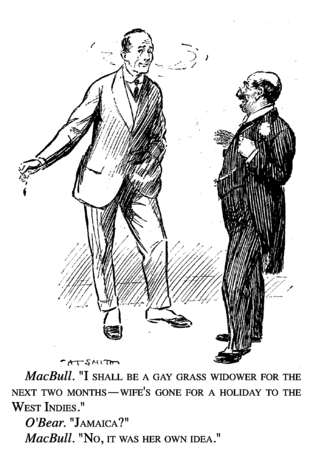
A pun, also rarely known as paronomasia, is a form of word play that exploits multiple meanings of a term, or of similar-sounding words, for an intended humorous or rhetorical effect. These ambiguities can arise from the intentional use of homophonic, homographic, metonymic, or figurative language. A pun differs from a malapropism in that a malapropism is an incorrect variation on a correct expression, while a pun involves expressions with multiple interpretations. Puns may be regarded as in-jokes or idiomatic constructions, especially as their usage and meaning are usually specific to a particular language or its culture.

A motto is a sentence or phrase expressing a belief or purpose, or the general motivation or intention of an individual, family, social group, or organisation. Mottos are usually found predominantly in written form, and may stem from long traditions of social foundations, or from significant events, such as a civil war or a revolution. One's motto may be in any language, but Latin has been widely used, especially in the Western world.

A slogan is a memorable motto or phrase used in a clan, political, commercial, religious, or other context as a repetitive expression of an idea or purpose, with the goal of persuading members of the public or a more defined target group. The Oxford Dictionary of English defines a slogan as "a short and striking or memorable phrase used in advertising". A slogan usually has the attributes of being memorable, very concise and appealing to the audience.

A television advertisement is a span of television programming produced and paid for by an organization. It conveys a message promoting, and aiming to market, a product, service or idea. Advertisers and marketers may refer to television commercials as TVCs.
Advertising slogans are short phrases used in advertising campaigns to generate publicity and unify a company's marketing strategy. The phrases may be used to attract attention to a distinctive product feature or reinforce a company's brand.

"Power to the people" is a cultural expression and political slogan that has been used in a wide variety of contexts.

"In God We Trust" is the official motto of the United States as well as the motto of the U.S. state of Florida, along with the nation of Nicaragua. It was adopted by the U.S. Congress in 1956, replacing E pluribus unum, which had been the de facto motto since the initial design of the Great Seal of the United States.

"Jedem das Seine" is the literal German translation of the Latin phrase suum cuique, meaning "to each his own" or "to each what he deserves".

"Don't Mess with Texas" is a slogan for a campaign aimed at reducing littering on Texas roadways by the Texas Department of Transportation (TxDOT). The phrase "Don't Mess with Texas" is prominently shown on road signs on major highways, television, radio and in print advertisements. The campaign is credited with reducing litter on Texas highways roughly 72% between 1987 and 1990. The campaign's target market was 18- to 35-year-old males, which was statistically shown to be the most likely to litter. While the slogan was not originally intended to become a statewide cultural phenomenon, it did.

Liberté, égalité, fraternité, French for 'liberty, equality, fraternity', is the national motto of France and the Republic of Haiti, and is an example of a tripartite motto. Although it finds its origins in the French Revolution, it was then only one motto among others and was not institutionalized until the Third Republic at the end of the 19th century. Debates concerning the compatibility and order of the three terms began at the same time as the Revolution. It is also the motto of the Grand Orient and the Grande Loge de France.
Pepsodent is an American brand of toothpaste with the minty flavor that is derived from sassafras. The brand was purchased by Unilever in 1942 and is still owned by the company outside of the United States and Canada. In 2003, Unilever sold the rights to the brand in the North American market to Church & Dwight.

Carling Black Label is a lager distributed by Carling Brewing Company.
A mari usque ad mare is the Canadian national motto. The phrase comes from the Latin Vulgate translation of Psalm 72:8 in the Bible:
"Et dominabitur a mari usque ad mare, et a flumine usque ad terminos terrae"
(King James Bible: "He shall have dominion also from sea to sea, and from the river unto the ends of the earth").
Hendiatris is a figure of speech used for emphasis, in which three words are used to express one idea. The phrases "sun, sea and sand", and "wine, women and song" are examples.
"Prouder, Stronger, Better", commonly referred to by the name "Morning in America", is a 1984 political campaign television commercial, known for its opening line, "It's morning again in America." The ad was part of that year's presidential campaign of Republican Party candidate Ronald Reagan. It featured a montage of images of Americans going to work, and a calm, optimistic narration that suggested that the improvements to the U.S. economy since the 1980 election were due to Reagan's policies. It also asked voters why they would want to return to the pre-Reagan policies of Democrats.

This glossary of literary terms is a list of definitions of terms and concepts used in the discussion, classification, analysis, and criticism of all types of literature, such as poetry, novels, and picture books, as well as of grammar, syntax, and language techniques. For a more complete glossary of terms relating to poetry in particular, see Glossary of poetry terms.

"Fortune favours the bold" or "fortune favours the brave" are among the English translations for a like-minded Latin proverb that has many variations: Audentes Fortuna Iuvat. The core meaning of the phrase has been widely used as a slogan in the Western world to emphasize concepts of courage and bravery, particularly within military organizations, and it is also used up to the present day on the coats of arms of numerous individual families and clans. It has historically served as a popular motto for universities, along with other academic and recreational institutions.

Galaxy Minstrels are milk chocolate buttons with a hard glazed shell sold in several countries including the UK, Republic of Ireland, South Africa, Kenya, Cyprus, Malta, Canada and Spain. In line with Mars' re-branding, Minstrels were brought under the Galaxy brand and are now sold as "Galaxy Minstrels", referring to the use of Galaxy chocolate in them.

"Make America Great Again" is an American political slogan and movement most recently popularized by Donald Trump during his successful 2016 presidential campaign. "MAGA" is also used to refer to Trump's political base, or to an individual or group of individuals from within that base. The slogan became a pop culture phenomenon, seeing widespread use and spawning numerous variants in the arts, entertainment and politics, being used by both those who support and those who oppose Trump's presidency. Originally used by Ronald Reagan as a campaign slogan in his 1980 presidential campaign, it has since been described as a loaded phrase. Multiple journalists, scholars, and commentators have called the slogan racist, regarding it as dog-whistle politics and coded language.















